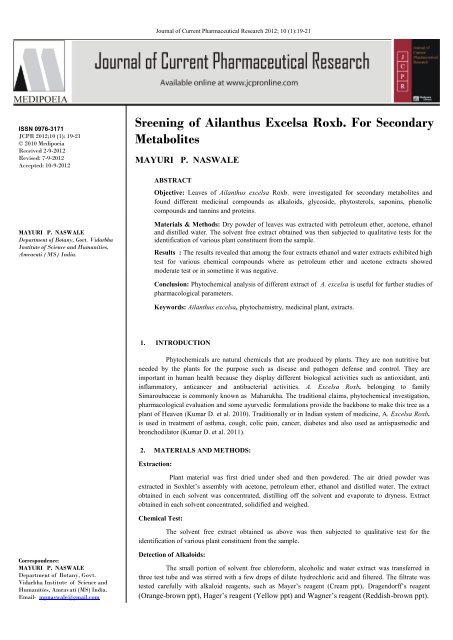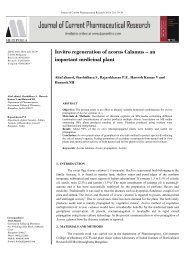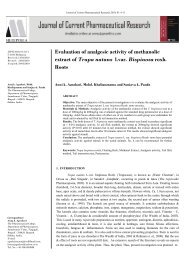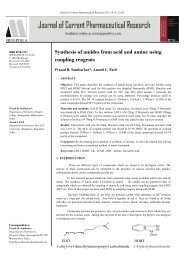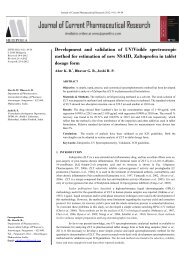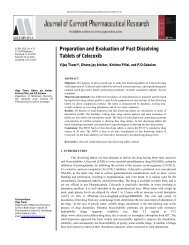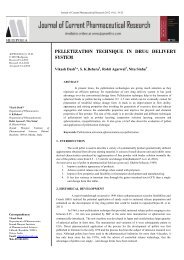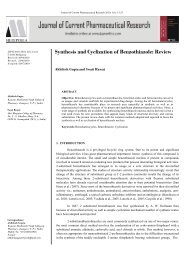Download PDF - Journal of Current Pharmaceutical Research
Download PDF - Journal of Current Pharmaceutical Research
Download PDF - Journal of Current Pharmaceutical Research
You also want an ePaper? Increase the reach of your titles
YUMPU automatically turns print PDFs into web optimized ePapers that Google loves.
<strong>Journal</strong> <strong>of</strong> <strong>Current</strong> <strong>Pharmaceutical</strong> <strong>Research</strong> 2012; 10 (1):19-21<br />
ISSN 0976-3171<br />
JCPR 2012;10 (1): 19-21<br />
© 2010 Medipoeia<br />
Received 2-9-2012<br />
Revised: 7-9-2012<br />
Accepted: 10-9-2012<br />
Sreening <strong>of</strong> Ailanthus Excelsa Roxb. For Secondary<br />
Metabolites<br />
MAYURI P. NASWALE<br />
ABSTRACT<br />
Objective: Leaves <strong>of</strong> Ailanthus excelsa Roxb. were investigated for secondary metabolites and<br />
found different medicinal compounds as alkaloids, glycoside, phytosterols, saponins, phenolic<br />
compounds and tannins and proteins.<br />
MAYURI P. NASWALE<br />
Department <strong>of</strong> Botany, Govt. Vidarbha<br />
Institute <strong>of</strong> Science and Humanities,<br />
Amravati (MS) India.<br />
Materials & Methods: Dry powder <strong>of</strong> leaves was extracted with petroleum ether, acetone, ethanol<br />
and distilled water. The solvent free extract obtained was then subjected to qualitative tests for the<br />
identification <strong>of</strong> various plant constituent from the sample.<br />
Results : The results revealed that among the four extracts ethanol and water extracts exhibited high<br />
test for various chemical compounds where as petroleum ether and acetone extracts showed<br />
moderate test or in sometime it was negative.<br />
Conclusion: Phytochemical analysis <strong>of</strong> different extract <strong>of</strong> A. excelsa is useful for further studies <strong>of</strong><br />
pharmacological parameters.<br />
Keywords: Ailanthus excelsa, phytochemistry, medicinal plant, extracts.<br />
1. INTRODUCTION<br />
Phytochemicals are natural chemicals that are produced by plants. They are non nutritive but<br />
needed by the plants for the purpose such as disease and pathogen defense and control. They are<br />
important in human health because they display different biological activities such as antioxidant, anti<br />
inflammatory, anticancer and antibacterial activities. A. Excelsa Roxb. belonging to family<br />
Simaroubaceae is commonly known as Maharukha. The traditional claims, phytochemical investigation,<br />
pharmacological evaluation and some ayurvedic formulations provide the backbone to make this tree as a<br />
plant <strong>of</strong> Heaven (Kumar D. et al. 2010). Traditionally or in Indian system <strong>of</strong> medicine, A. Excelsa Roxb.<br />
is used in treatment <strong>of</strong> asthma, cough, colic pain, cancer, diabetes and also used as antispasmodic and<br />
bronchodilator (Kumar D. et al. 2011).<br />
2. MATERIALS AND METHODS:<br />
Extraction:<br />
Plant material was first dried under shed and then powdered. The air dried powder was<br />
extracted in Soxhlet’s assembly with acetone, petroleum ether, ethanol and distilled water. The extract<br />
obtained in each solvent was concentrated, distilling <strong>of</strong>f the solvent and evaporate to dryness. Extract<br />
obtained in each solvent concentrated, solidified and weighed.<br />
Chemical Test:<br />
The solvent free extract obtained as above was then subjected to qualitative test for the<br />
identification <strong>of</strong> various plant constituent from the sample.<br />
Correspondence:<br />
MAYURI P. NASWALE<br />
Department <strong>of</strong> Botany, Govt.<br />
Vidarbha Institute <strong>of</strong> Science and<br />
Humanities, Amravati (MS) India.<br />
Email- mpnaswale@gmail.com<br />
Detection <strong>of</strong> Alkaloids:<br />
The small portion <strong>of</strong> solvent free chlor<strong>of</strong>orm, alcoholic and water extract was transferred in<br />
three test tube and was stirred with a few drops <strong>of</strong> dilute hydrochloric acid and filtered. The filtrate was<br />
tested carefully with alkaloid reagents, such as Mayer’s reagent (Cream ppt), Dragendorff’s reagent<br />
(Orange-brown ppt), Hager’s reagent (Yellow ppt) and Wagner’s reagent (Reddish-brown ppt).
<strong>Journal</strong> <strong>of</strong> <strong>Current</strong> <strong>Pharmaceutical</strong> <strong>Research</strong> 2012; 10 (1):19-21<br />
Detection <strong>of</strong> Carbohydrates and Glycosides:<br />
A small quantity <strong>of</strong> alcoholic and aqueous extracts was<br />
dissolved separately in 5 ml <strong>of</strong> distilled water and filtered. The<br />
filtrate was subjected to Molisch’s test for detection <strong>of</strong><br />
carbohydrates.<br />
Small portion <strong>of</strong> the same extract was hydrolyzed with<br />
dilute hydrochloric acid for few hours in water bath and was<br />
subjected to Libermann-Burchard’s test for detection <strong>of</strong> glycosides.<br />
Detection <strong>of</strong> Phytosterols:<br />
A small quantity <strong>of</strong> ether, ethanol and water extracts was<br />
tested for presence <strong>of</strong> sterols with Libermann-Burchard’s reagent.<br />
Detection <strong>of</strong> Fixed Oils:<br />
A small quantity <strong>of</strong> petroleum ether and benzene extracts<br />
was passed separately between two filter papers. Oil stains on the<br />
paper indicated the presence <strong>of</strong> fixed oil.<br />
Detection <strong>of</strong> Saponins:<br />
About 1 ml <strong>of</strong> alcoholic and aqueous extracts was diluted<br />
separately with distilled water to 20 ml and shaken in graduated<br />
cylinder for 15 minutes. One cm layer <strong>of</strong> foam indicated presence<br />
<strong>of</strong> saponins.<br />
Detection <strong>of</strong> Phenolic Compounds and Tannins:<br />
Small quantity <strong>of</strong> alcoholic and aqueous extracts in water<br />
was tested for the presence <strong>of</strong> phenolic compounds and tannins<br />
with dilute ferric chloride solution (5%) and 10% lead acetate<br />
solution.<br />
Detection <strong>of</strong> Proteins:<br />
Small quantity <strong>of</strong> alcoholic and aqueous extract was<br />
dissolved in a few ml <strong>of</strong> water and subjected to Biuret test.<br />
Detection <strong>of</strong> Gums and Mucilages:<br />
About 10 ml <strong>of</strong> aqueous extract was added to 25 ml <strong>of</strong><br />
absolute alcohol with constant stirring. The precipitate was dried in<br />
air. It was examined for it’s swelling property.<br />
Detection <strong>of</strong> Volatile Oils:<br />
Volatile oil was detected in the ether extract. Aromatic<br />
smell in the evaporated ether extract indicated presence <strong>of</strong> volatile<br />
oils.<br />
3. RESULTS AND DISCUSSION:<br />
Preliminary phytochemical screening has done <strong>of</strong> leaves<br />
powder and results are incorporated in Table-I and Table–II. Result<br />
in table I showed the texture and color <strong>of</strong> extracts in different<br />
solvents. Results <strong>of</strong> the phytochemical screening were presented in<br />
Table II. It revealed the presence <strong>of</strong> alkaloids, glycosides,<br />
phytosterols, saponins, phenolic compounds and tannins and<br />
proteins whereas fixed oils, gums, mucilage and volatile oils are<br />
absent. In earlier study different medicinal compounds such as<br />
Alkaloids, glycoside, phenol, phytosterols, saponins and tannins<br />
were present (Baycu G. et al. 2008; Bhatt S. et al. 2012; Kumar D.<br />
et al. 2010; Said A. et al. 2010).<br />
Table I: Nature and Colour <strong>of</strong> various Extracts <strong>of</strong> Ailanthus<br />
excelsa Roxb.<br />
Extract Texture Colour<br />
Acetone<br />
Petroleum Ether<br />
Ethanol<br />
Table II<br />
Test<br />
Alkaloids<br />
Distilled Water<br />
Mayer’s<br />
Dragendr<strong>of</strong>f’s<br />
Hager’s<br />
Wagner’s<br />
Carbohydrates<br />
Glycosides<br />
Molisch’s<br />
Libermann-<br />
Burchard’s<br />
Phytosterols<br />
Libermann-<br />
Burchard’s<br />
&<br />
Sticky<br />
Sticky<br />
Sticky<br />
Sticky<br />
Petroleum<br />
Ether<br />
– ve<br />
– ve<br />
– ve<br />
– ve<br />
–ve<br />
–ve<br />
Green<br />
Green<br />
Green<br />
Green<br />
Acetone Ethanol Distilled<br />
Water<br />
–ve<br />
–ve<br />
–ve<br />
–ve<br />
–ve<br />
–ve<br />
+++ve<br />
++ve<br />
++ve<br />
+++ve<br />
++ve<br />
++ve<br />
+++ve<br />
++ve<br />
++ve<br />
+++ve<br />
+++ve<br />
+++ve<br />
++ve +ve ++ve –ve<br />
Fixed Oils –ve –ve –ve –ve<br />
Saponins –ve –ve ++ve ++ve<br />
Phenolic Compounds &<br />
Tannins<br />
Proteins<br />
Lead Acetate<br />
Ferric chloride<br />
–ve<br />
–ve<br />
++ve<br />
++ve<br />
++ve<br />
++ve<br />
-ve<br />
-ve<br />
Biuret Reagent –ve –ve +ve +ve<br />
Gums & Mucilages<br />
Molisch’s –ve –ve –ve –ve<br />
Volatile Oils –ve –ve –ve –ve
<strong>Journal</strong> <strong>of</strong> <strong>Current</strong> <strong>Pharmaceutical</strong> <strong>Research</strong> 2012; 10 (1):19-21<br />
4. REFERENCES:<br />
Baycu G., Said A., Farag A.and Rashid K. Protein patterns and<br />
chemical constituents <strong>of</strong> Ailanthus altissima (Miller) Swingle and<br />
Ailanthus excelsa Roxb.IUFS <strong>Journal</strong> <strong>of</strong> Biology, (2008) 67 (1): 81-88.<br />
Bhatt S. and Dhyani S. Preliminary phytochemical screening <strong>of</strong><br />
Ailanthus excelsa Roxb. International <strong>Journal</strong> <strong>of</strong> <strong>Current</strong> <strong>Pharmaceutical</strong><br />
<strong>Research</strong>. 2012 4(1): 87-89.<br />
Kirtikar K. R. and Basu B. D. Indian Medicinal Plants, Vol. 1<br />
International Book Distributors, Dehradun, India. ;1995 371-372.<br />
Kumar D., Bhatt Z. A., Singh P., Khatanglakar and Bhujbal S. S.<br />
Anti-asthmatic and anti-allergic potential <strong>of</strong> methanolic extract <strong>of</strong> leaves<br />
<strong>of</strong> Ailanthus excelsa Roxb. Revista Brasileira de Farmacognozia.<br />
Brazilian <strong>Journal</strong> <strong>of</strong> Pharmacognosy, 2011 21(1): 139-145.<br />
Kumar D., Bhatt Z. A., Singh, Shah M. V., Bhujbal S. S. and<br />
Patil D. Y. Ailanthus excelsa Roxb. is really a plant <strong>of</strong> Heaven.<br />
International <strong>Journal</strong> <strong>of</strong> Pharmacology, 2010 6(5): 535-555<br />
Said A., Hawas U. W., El-Shenoy S., N<strong>of</strong>al S. M. and Rashid<br />
K. Flavonoids and some biological activities <strong>of</strong> Ailanthus excelsa Roxb.<br />
IUFS <strong>Journal</strong> <strong>of</strong> Biology. 2010 69(1): 45-55.


